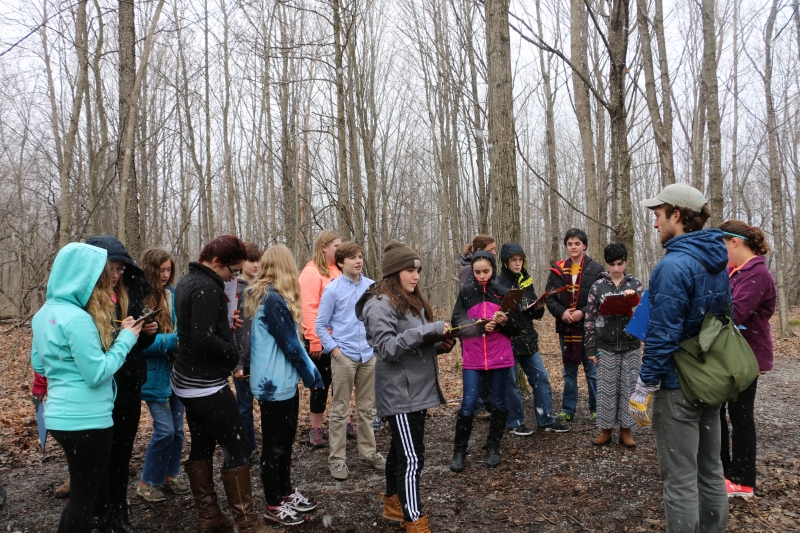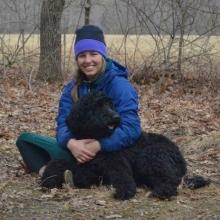
Citizen Science in the North Country
On a snowy morning in April, students in Suzanne Creurer's seventh grade Technology class at Canton Central School took a field trip into the woods. Their destination was the maple tree grove, and their purpose was citizen science (citizen science relies on the general public to collect data about the natural world for scientific research). As a group, they work with Nature Up North on the Monitor My Maple project to collect data about their local environment.
The Monitor My Maple project is one of Nature Up North's citizen science efforts, which schools across the North Country are participating in. Each student is assigned a maple tree that they visit and observe throughout the year. Students record the timing of color change and leaf drop in the fall, and budding and flowering of the trees in the spring, then enter their data on natureupnorth.org. Mrs. Cruerer's class has been participating in the project since 2014.
 Jake reminds students how to measure the circumference of trees while they prepare to record their observations.
Jake reminds students how to measure the circumference of trees while they prepare to record their observations.
As we walked across the muddy soccer field to the woods where the maple grove was, I tried to gauge students' level of excitement about being a citizen scientist. "What do you like most about the Monitor My Maple project," I asked a group of thirteen-year-old boys. Most of their answers were that they got to go outside, since they don't get to do that in any of their other classes. But some touched on a deeper appreciation. "I've always been infatuated with outside stuff like animals, plants, the ocean, outer space. Not so much inside stuff. Just seeing how things intertwine with each other, seeing how they react - there's always a reaction for things that happen," Tyler, a tall boy in a bright orange sweatshirt told me. His eloquence caught me off guard, and it didn't stop there.
"We need to preserve and monitor in order to make sure our maple trees are good so that if there's something wrong with them we could figure out why and kinda look for that in other trees. If one thing disappears, another thing disappers. Or if it appears more often, such as bugs attaching the crops more often, then we lose a food source."
On this day the students are just starting to monitor their maples again after a long winter apart. They began by measuring the circumference of each tree to check for any growth since the fall - not much, since trees are dormant in cold weather. Soon, they will be going out regualarly to record the dates of bud burst and first flowerings. Their observations are going to become part of a larger data set that Nature Up North is collecting over time, in order to better understand how maples are responding to climate change. Evidence suggests that sugar maples in Northern New York are in decline, and projects like this will helps us monitor the health of these iconic local species.
 Students work together to take measurements.
Students work together to take measurements.
At first, it may not seem like noticing the date of the first maple buds could have any value to the scientific world, but Robin Wall Kimmerer, a professor of Environmental and Forest Biology at SUNY ESF in Syracuse, disagrees. In a recent interview with The Sun Magazine, Kimmerer states, "paying attention to nature has evolutionary value for a culture. If you don't pay attention to the circumstances under which the salmon return to the rivers to spawn, you will fail at fishing. So there has always been great impetus to make meaning from data."
Nature Up North is working to build tools that enable North Country residents to share their observations from the natural world online and helps create a collective sense of meaning. Our Encounter feature lets you share photos and narratives from your nature experiences and tag them to our map. Posting an Encounter on Nature Up North establishes a database in the North Country from which we can start to notice larger environmental trends.
 These are just some of the many beautiful scenes that North Country residents share as Encounters through Nature Up North.
These are just some of the many beautiful scenes that North Country residents share as Encounters through Nature Up North.
Temperature, rainfall, frosts, and thaws are all climactic information that can be obtained from an ordinary photograph. By taking a picture of a plant or animal, you are recording that species' existence at a certain point in time. WIth the current pace of environmetal change that we are perpetuating as a planet, some species might not be around for much longer, so citizen science projects like Encounters can help keep track of what was once normal. It can also be unifying to share an experience with other North Country residents. If you post photos from your morning walk, maybe someone will be inspired to get up early the next day too; if someone shares a poem that they wrote about moss, maybe you'll dust off your journal. It can be a way to discover new spots on the North Country that you can explore; the map shows where each Encounter happened. By creating an online community of shared nature experiences, we are encouraging each other to get outside and make our own connections.
 Over 1,500 Encounters have been shared on NatureUpNorth.org so far, from all over St. Lawrence County. Their locations are plotted on an interactive map.
Over 1,500 Encounters have been shared on NatureUpNorth.org so far, from all over St. Lawrence County. Their locations are plotted on an interactive map.
Students aren't the only ones who can be citizen scientists. Anyone can record observations about a maple in their backyard or in the local park and contribute to the Monitor My Maple project. Learn how here. And anyone can post an Encounter at any time - get some inspiration and see what other North Country residents are encountering here.
Citizen Science Day is coming up on April 16th, so now is your chance to get involved! Join us for our Citizen Science Day hike, or help us celebrate Earth Day on April 22nd by participating in our Encounter Earth campaign!
For the record, Tyler used to want to be a paleontologist, but not anymore. Now he wants to focus on preserving the present for the future instead of studying the past, because he realizes how crucial it is for our planet. I told him he would be a great environmentalist someday, and then I realized how wrong I was. He already is one.

